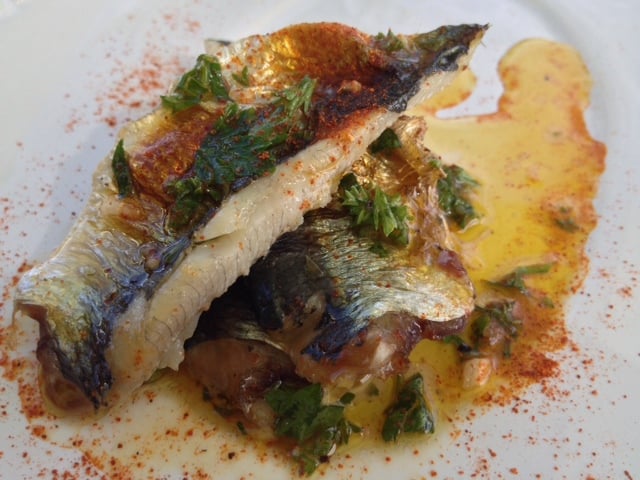I was lucky enough to get my hands on some freshly caught sardines this week—and they caught me quite off guard. I’d never dealt with the whole fish before. Come to think of it, I’d never done anything but pluck them from a can. But when a client requested fresh sardines, I finally realized what I’d been missing out on!
My first surprise was learning just how fast and easy it is to prepare sardines for the table. Once I found my groove, I was able to do the beheading, gutting, and boning in mere seconds. Hardly thirty minutes later, I looked down to find six pounds of prepped sardines. My next surprise was the taste. Tender, flaky, and not quite so fishy as their canned counterparts, after one bite, I knew I’d be searching out these guys far more often. I’d say the same even if they did take more time and effort to prepare. That’s just how good they were. An added bonus is that when it comes to fresh fish, sardines are one of the most sustainable choices you can make, due in part to their short life span. And because they live at the bottom of the oceanic food chain, sardines also contain much lower levels of mercury and other contaminants than other fish on the market.
Flavor and ease of preparation aside, an even bigger reason to seek out fresh sardines is their amazingly rich nutrient profile. Packed with protein and low in calories, sardines are an excellent source of potassium and vitamin B12. The majority of us happen to be deficient in B12, yet it plays a key role in the normal functioning of the brain and nervous system. Low levels can contribute to memory loss, fatigue, and depression. Sardines are second only to calf’s liver in their concentrated percentage of this vital nutrient. In fact, a tiny three-ounce portion of sardines meets a whopping 135 percent of our daily requirement.
Sardines are also an awesome source of bone-fortifying vitamin D. Though not readily available in our diets, we need vitamin D to encourage the body’s absorption of calcium and phosphorus. Finally, sardines are one of the most concentrated sources of omega-3 fatty acids EPA and DHA, associated with clearing arteries, reducing inflammation, slowing the aging process, and increasing intellectual development and cognitive function.
This recipe highlights the briny essence of the humble sardine by keeping it simple and full of flavor. For a tasty appetizer or snack, feel free to serve with crusty bread or crackers to mop up every last drop of juice.
Ingredients
Serves 4–6
1/4 cup freshly squeezed lemon juice
3 cloves garlic, minced
1/2 cup olive oil
1/4 cup chopped parsley
1/2 teaspoon smoked paprika
Salt and cracked pepper, to taste
2 pounds whole fresh sardines (may also use frozen and thawed)
Olive oil
1. Preheat broiler to high. Prepare marinade: combine lemon juice, garlic, olive oil, parsley, and paprika in a measuring cup. Season liberally with salt and freshly cracked pepper. Set aside until after filets have cooked.
2. Set an oven rack about 4–6 inches from broiler. Prepare sardines by snapping off head and sliding thumb from belly to tail. Clean innards from fish. Spread the fish open, like a book, and slide your fingertips under the rib cage by the head to loosen bones a little. Grab the backbone between thumb and forefinger, and gently pull down towards the tail to remove the bones. This is much easier than it sounds. As you finish each fish, drop it into a bowl of ice water. Once all of the fish are deboned, rinse the filets and pat dry with paper towels.
3. Line a baking sheet with parchment paper. Spread sardines in a single layer, skin side down, and drizzle with olive oil. Season with salt and pepper. Flip filets over, and drizzle with additional olive oil. Place in oven, skin side up, and broil until browned and fish is just cooked through, about 4–6 minutes.
4. Remove from oven and cool until warm. Carefully cut or tear filets in half (I used scissors) and place on a serving dish. Spoon marinade atop sardines. For best results, marinate in refrigerator for an hour—or eat immediately if you just can’t wait. Serve chilled or at room temperature. Any leftovers would be delicious tossed with spaghetti or other pasta.
AUTHOR’S NOTE
To choose your organically grown and fresh ingredients wisely, use the following criteria:
·chemical- and hormone-free meat
·wild-caught fish
·pastured-raised, organic eggs
·whole, unrefined grains
·virgin, unrefined, first-press organic oils
·whole-food, unrefined sweeteners
·pure, clean, spring water
·sea salt
·raw and/or cultured milk and cream products


